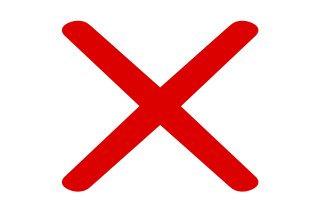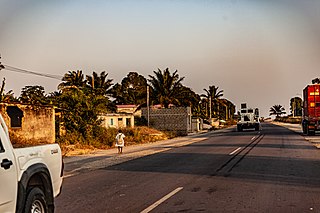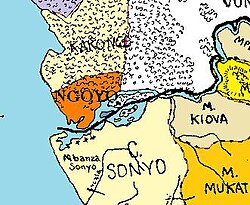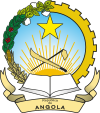
Benguela is a province of Angola, situated in the west of the country. It lies on the Atlantic Ocean, and borders the provinces of Cuanza Sul, Namibe, Huila, and Huambo. The province has an area of 39,826 square kilometres (15,377 sq mi) and its capital is Benguela. According to the 2014 census, there were 2,231,385 inhabitants in the province. The current governor of Benguela is Isaac dos Anjos.

The Kingdom of Ndongo was an early-modern African state located in the highlands between the Lukala and Kwanza Rivers, in what is now Angola.
The pre-colonial history of the modern-day Democratic Republic of the Congo encompasses the history of the Congo Basin region up to the establishment of European colonial rule in the era of New Imperialism and particularly the creation of the Congo Free State and its expansion into the interior after 1885. As the modern territorial boundaries of the Democratic Republic of the Congo did not exist in this period, it is inseparable from the wider pre-colonial histories of Central Africa, the Great Lakes and Rift Valley as well as the Atlantic World and Swahili coast.

The Kingdom of Kongo was a kingdom in Central Africa. It was located in present-day northern Angola, the western portion of the Democratic Republic of the Congo, Southern of Gabon and the Republic of the Congo. At its greatest extent it reached from the Atlantic Ocean in the west to the Kwango River in the east, and from the Congo River in the north to the Kwanza River in the south. The kingdom consisted of several core provinces ruled by the Manikongo, the Portuguese version of the Kongo title Mwene Kongo, meaning "lord or ruler of the Kongo kingdom", but its sphere of influence extended to neighbouring kingdoms, such as Ngoyo, Kakongo, Loango, Ndongo, and Matamba, the latter two located in what is Angola today.

Soyo is a city, with a population of 200,920, and a municipality, with a population of 227,175, located in the province of Zaire in Angola, at the mouth of the Congo River. Historically, Soyo was a significant city in conflicts between the Kingdom of Kongo, Portuguese Angola, and the Dutch West India Company. Soyo became an independent state in the 17th century and had significant influence on politics in Kongo during the Kongo Civil War.

Garcia II Nkanga a Lukeni a Nzenze a Ntumba, also known as Garcia Afonso for short, ruled the Kingdom of Kongo from 23 January 1641 to 1661. He is sometimes considered Kongo's greatest king for his religious piety and his near expulsion of the Portuguese from Angola. Yet, he is also notorious for enriching himself through his leading role in the Atlantic slave trade.

Kakongo was a small kingdom located on the Atlantic coast of Central Africa, in the modern-day Republic of the Congo and Cabinda Province, Angola. In the 13th century, it formed part of a confederation led by Vungu. Along with its neighboring kingdoms of Ngoyo and Loango, Kakongo became an important political commercial center during the 17th through 19th centuries. The people speak a dialect of the Kikongo language and thus may be considered a part of the Bakongo ethnicity. Kakongo was a vassal of the Kingdom of Kongo for a part of its history.

The Kimpanzu were members of the Mpanzu kanda also known as the House of Kimpanzu, one of the lineages from which the kings of Kongo were chosen during the 17th century and following Kongo's reunification under Pedro IV. They are remembered in tradition and are evoked in a proverb, still current in the 1920s Nkutama a mvila za makanda "Kinlaza, Kimpanzu ye Kinlaza makukwa matatu malambila Kongo".
John K. Thornton is an American historian specializing in the history of Africa, the African Diaspora and the Atlantic world. He is a professor in the history department at Boston University.
The Battle of Kitombo was a military engagement between forces of the BaKongo state of Soyo, formerly a province of the Kingdom of Kongo, and the Portuguese colony of Angola on 18 October 1670. Earlier in the year a Portuguese expeditionary force had invaded Soyo with the intention of ending its independent existence. The Soyo were supported by the Kingdom of Ngoyo, which provided men and equipment, and by the Dutch, who provide guns, light cannon and ammunition. The combined Soyo-Ngoyo force was led by Estêvão Da Silva, and the Portuguese by João Soares de Almeida. Both commanders were killed in the battle, which resulted in a decisive victory for Soyo. Few, if any, of the invaders escaped death or capture.
Pedro III Nsimba Ntamba was a ruler of the Kingdom of Kongo during its tumultuous civil war period. He was the elder brother of King Joāo II and one of many partisans of the House of Kinlaza. Since 1666, the two royal kandas, or lineages, Kinlaza and Kimpanzu, had been fighting bitterly over the Kingdom of Kongo.
The Kongo Civil War (1665–1709) was a war of succession between rival houses of the Kingdom of Kongo. The war waged throughout the middle of the 17th and 18th centuries pitting partisans of the House of Kinlaza against the House of Kimpanzu. Numerous other factions entered the fray claiming descent from one or both of the main parties such as the Água Rosada of Kibangu and the da Silva of Soyo. By the end of the war, Kongo's vaunted capital had been destroyed and many Bakongo were sold into the Trans-Atlantic Slave Trade.
The Battle of Mbidizi River was a military engagement in June 1670 between forces of the County of Soyo and those of the Portuguese colony of Angola during the Kongo Civil War. The engagement was part of a military campaign to break the power of Soyo in the region. The Portuguese won a decisive victory, inflicting heavy casualties and killing the Soyon leader.

Garcia I Mvemba a Nkanga was a manikongo of Kongo who ruled from April 27, 1624 to March 7, 1626.

Álvaro VI of Kongo, sometimes called Nimi a Lukeni a Nzenze a Ntumba, was a ruler of the Kingdom of Kongo.

In southwestern Africa, Portuguese Angola was a historical colony of the Portuguese Empire (1575–1951), the overseas province Portuguese West Africa of Estado Novo Portugal (1951–1972), and the State of Angola of the Portuguese Empire (1972–1975). It became the independent People's Republic of Angola in 1975.
Rafael I Nzinga a Nkanga was a ruler of the Kingdom of Kongo during its civil war. He ruled from 1670 to 1673.
The Battle of Mbumbi was a military engagement between forces of Portuguese Angola and the Kingdom of Kongo in 1622. Although the Portuguese were victorious, the battle served as the impetus for the Kingdom of Kongo to expel the Portuguese from their territory.
Henrique III Mpanzu a Nsindi a Nimi a Lukeni was ruler of the Kingdom of Kongo from the Kivuzi branch of the Kinlaza house, who reigned from 1840 until 1857.











